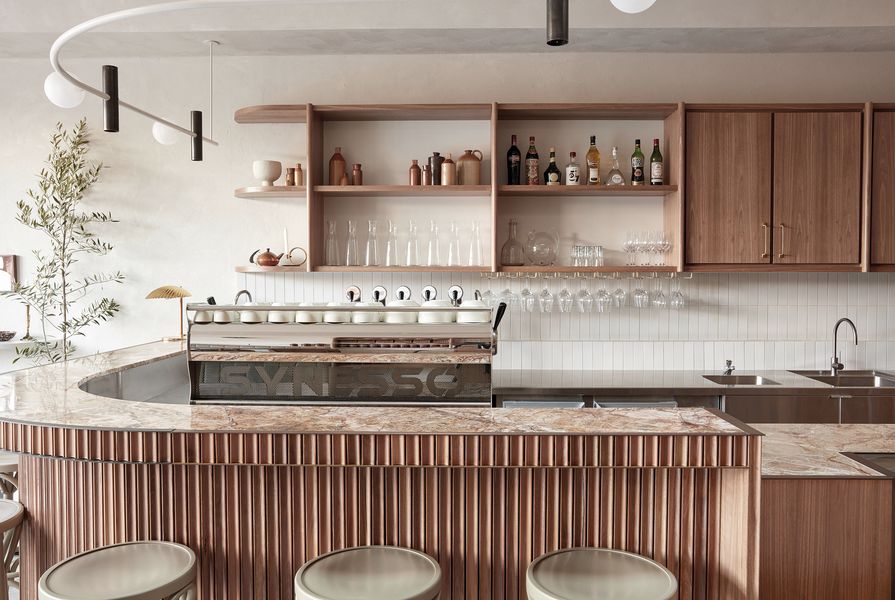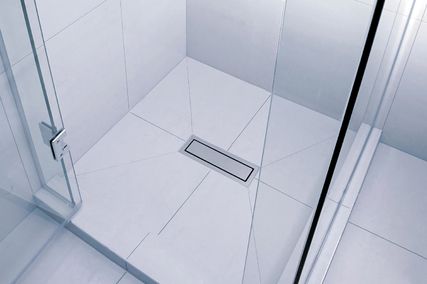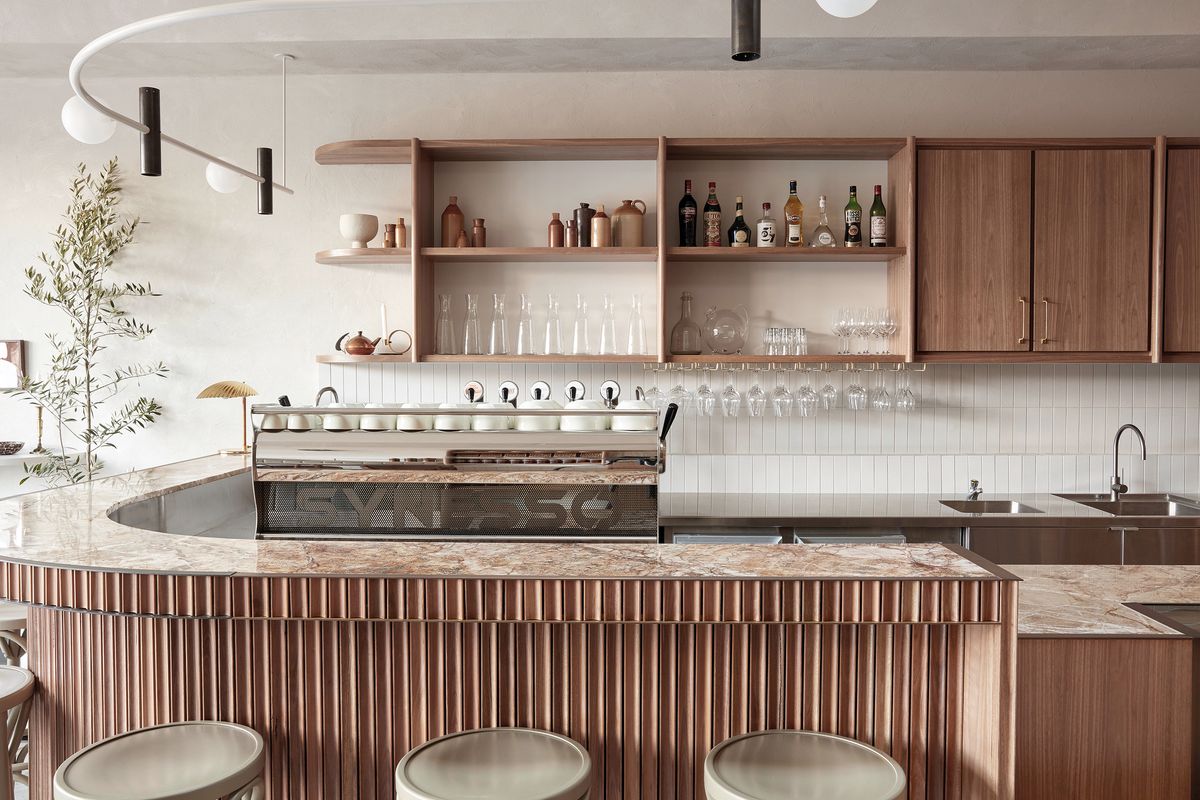The design of Via Porta has been approached as an urban exercise, an attempt to construct experiences reminiscent of the density and complexity of narrow Italian alleyways in a distinctly different setting. The project also demonstrates a detailed understanding of hospitality, employing design skills to support and value the processes and rituals inherent in preparing and sharing food.
The site in suburban Mont Albert didn’t immediately suggest a Mediterranean connection. An anonymous aluminium shopfront, previously home to a manufacturer of trophies, sat behind a small asphalt forecourt alongside a few similarly uninspiring neighbours, adrift from any established retail centre. Although lacking in apparent character from the street, the building did have several appealing attributes: convenient access for loading and deliveries via the rear lane, an unexpected complexity in section (including a basement, double-height void and mezzanine) and owner-occupier clients with a commitment to complete reinvention.
Studio Esteta has an usually close connection to this project – co-director Sarah Cosentino is also a co-owner of Via Porta, a distinctly family affair run by her three brothers. Such commissions can be fraught for any designer but here it appears that the skill and experience of all parties has ensured that family bonds have remained intact.
Trust in the client’s knowledge allowed Studio Esteta to follow their preferred process for hospitality projects – an intense early emphasis on spatial flow and operational requirements in plan, with the aim to get the kitchen and critical inventory right, allowing the clients to avoid any initial “anxiety of aesthetics.” Throughout the project, they developed an overarching focus on a shared Italian upbringing, where heritage, quality ingredients and an understanding of process are all valued and equally relevant to preparing a family dinner or designing a cafe.
A good example of this approach is the crazy paved floor that flows throughout. A combination of traditional skills, engaged clients and dogged determination by hands-on designers saw the Consentino siblings scouring stoneyards and stockpiling suitable scraps. Detailed colour-coded instructions to the tilers has resulted in a considered balance of textures and hues that eventually deepen into darker tones within the plum-coloured bathroom grotto under the stair.
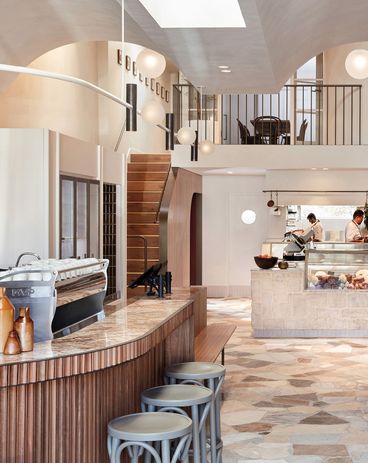
The long, thin site lent itself to the use of linear organizational arrangements such as streets and alleys, which in turn add logic to the determined use of exterior materials and textures throughout. The project scope is greater than it first appears, and included extending the upper level of the building, adding extensive kitchen facilities and completely transforming the appearance from the street.
The former trophy shop is now unrecognizable, with a crisp white facade of steel-framed glazing and large canvas awning making a far more urban and generous contribution to the neighbourhood. Customers pass a symbolic lamppost and enter via a compact outdoor terrace. The large curving coffee bar makes the first impression inside. Carefully sourced (and appropriately named) “Golden Cappuccino” marble surrounds the gleaming espresso machine. Trimmed in brass and offset against fluted timber panelling, the bar is an elegant interpretation of the traditional Italian shrines to espresso. Custom-designed lighting fabricated by Daniel Giffin curls overhead, combining directional and ambient lighting to allow the vaulted ceiling to be left clean and simple.
Upon entering Via Porta, patrons are welcomed into the dining area, which features a banquette that transitions into merchandise shelving.
Image: Sean Fennessy
The competing demands of dining and retail space are casually balanced as a wall of shelving and tiled plinths leads to the deli and kitchen beyond, the neutral tones allowing the colourful jars and bright Italian packaging to take centre stage. Display fridges are carefully customized and integrated, while olive trees, vintage ceramics and framed family photos add personal touches throughout.
The centre of the plan has been transformed into a skylit double-height volume, a micro-piazza anchored by the rough-hewn stone of the deli counter and overlooked by the balcony of the compact dining room upstairs. The kitchen is apparent but not completely open, deliberately maintaining some privacy while allowing unexpected views through to treetops beyond. Both the main kitchen and basement preparation area have new windows that provide daylight and outlook – a priority for the clients who occupy those spaces.
Studio Esteta has previously proved more than capable of theatrical spectacle in projects such as Lune Croissanterie. However, Via Porta sidesteps the desire for a photo-ready moment. This project privileges the personal; it is the built embodiment of a warm welcome from a hospitable family, a confident assembly of form, space and familiar materials dedicated to the preparation and sharing of food.
Products and materials
- Walls
- All walls in Dulux ‘White Duck.’ Exterior facade wall with a raked render finish. Interior walls with trowelled render finish. Interior skirting tiles are Inax by Artedomus.
- Windows and doors
- Custom steel-framed facade system, including door and gas-lift window, by Formanova.
- Flooring
- Custom crazy paving designed by Studio Esteta, marble and stone pieces sourced from Attila’s Natural Stone & Marble. Oak Marla Rustic timber floorboards by Havwoods. Bar and deli floor tiles are Fortezza Guyana Ivory floor tiles from Metz Tiles.
- Lighting
- Custom lighting designed by Studio Esteta, including bar pendant, external lamppost and high-level pendant lights, manufactured by Daniel Giffin. Volker Haug Studio Anton mini wall lights. Lights from Ambience.
- Furniture
- Round bar stool (tall and low) by Thonet. Chair 14, Chair 18 and Armchair 30 and 18 by Ton supplied through James Richardson Furniture. Inox 4401 table bases by Pedrali in antique bronze finish supplied through James Richardson Furniture. Colorado table bases supplied by Hospitality Furniture Concepts in custom powdercoat finish.
- Bathroom
- Phoenix Basin Mixer in gun metal finish and Caroma Cube Extension wall basin, both supplied through Reece.
- External elements
- GB Masonry rock face blocks and smooth face blocks by Austral Bricks, supplied by Brickworks.
Credits
- Project
- Via Porta
- Design practice
- Studio Esteta
Abbotsford, Melbourne, Vic, Australia
- Project Team
- Sarah Cosentino, Felicity Slattery, Hannah-Lee Hughes, Monique Woods
- Consultants
-
Builder
Adept Construction
Kitchen contractor Trent Refrigeration
Structural engineer Keith Long and Associates
- Aboriginal Nation
- Built on the land of the Wurundjeri people of the Kulin Nation.
- Site Details
-
Location
Melbourne,
Vic,
Australia
Site type Urban
- Project Details
-
Status
Built
Design, documentation 12 months
Construction 6 months
Category Hospitality, Interiors
Type Adaptive re-use, Bars and cafes
Source
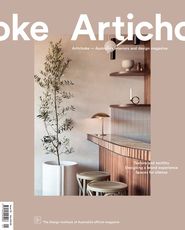
Project
Published online: 8 Oct 2020
Words:
Michael Macleod
Images:
Sean Fennessy
Issue
Artichoke, March 2020

